Comprehensive Analysis of Financial and Economic Literacy Report
VerifiedAdded on 2023/04/20
|15
|3766
|295
Report
AI Summary
This report delves into the core concepts of financial and economic literacy, examining consumer sovereignty, market structures, and financial management principles. It analyzes consumer sovereignty as a driver of production decisions, contrasting it with the view that businesses manipulate markets. The report then explores various market structures, including perfect competition, monopoly, oligopoly, and monopolistic competition, providing examples of each. Furthermore, it contrasts profit maximization with wealth maximization in financial management, arguing for the superiority of wealth maximization in contemporary organizations. Finally, the report touches upon the environmental policies of the United Kingdom government. The report offers a comprehensive overview of these interconnected economic and financial concepts, providing valuable insights into market dynamics and financial decision-making.
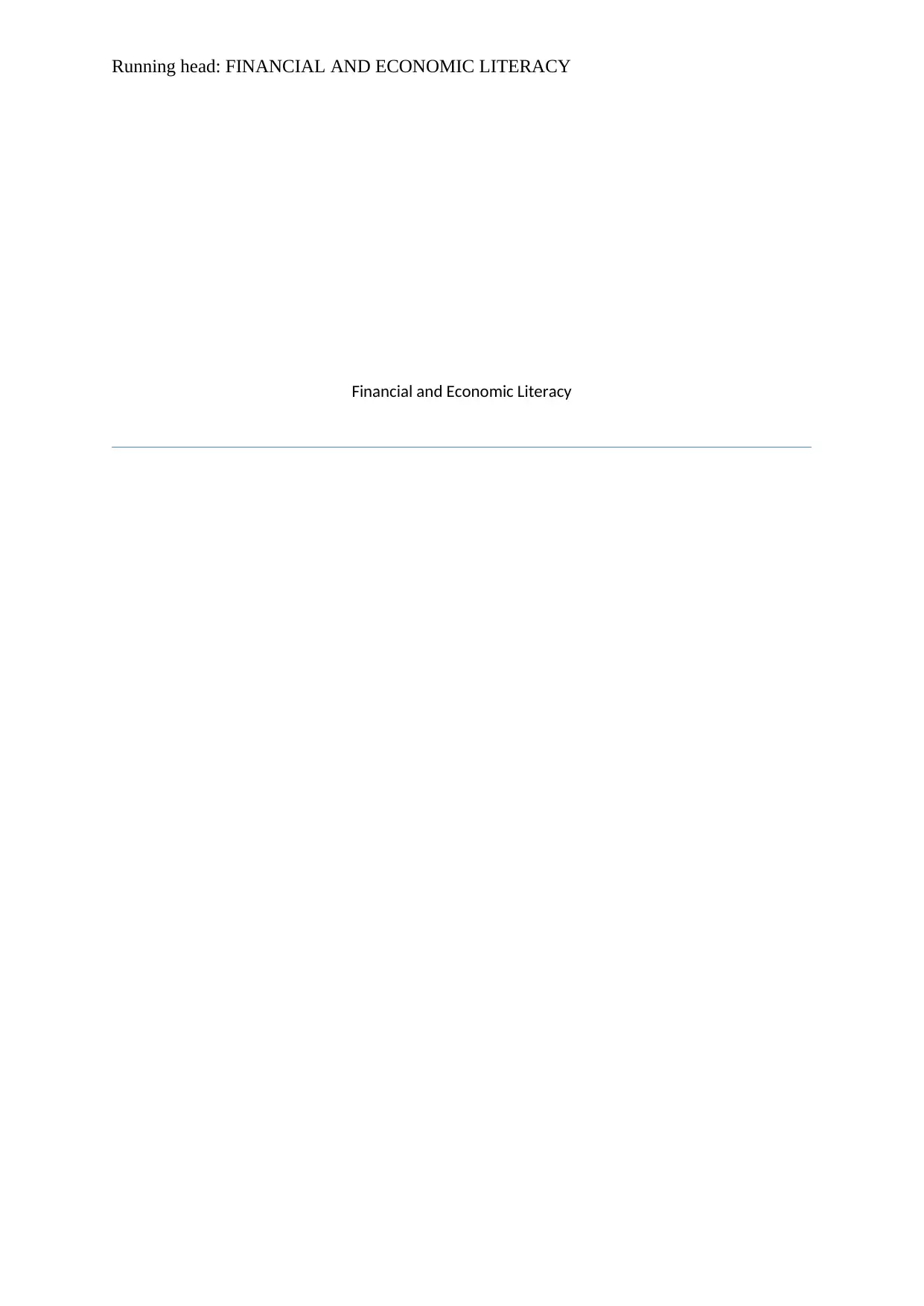
Running head: FINANCIAL AND ECONOMIC LITERACY
Financial and Economic Literacy
Financial and Economic Literacy
Paraphrase This Document
Need a fresh take? Get an instant paraphrase of this document with our AI Paraphraser
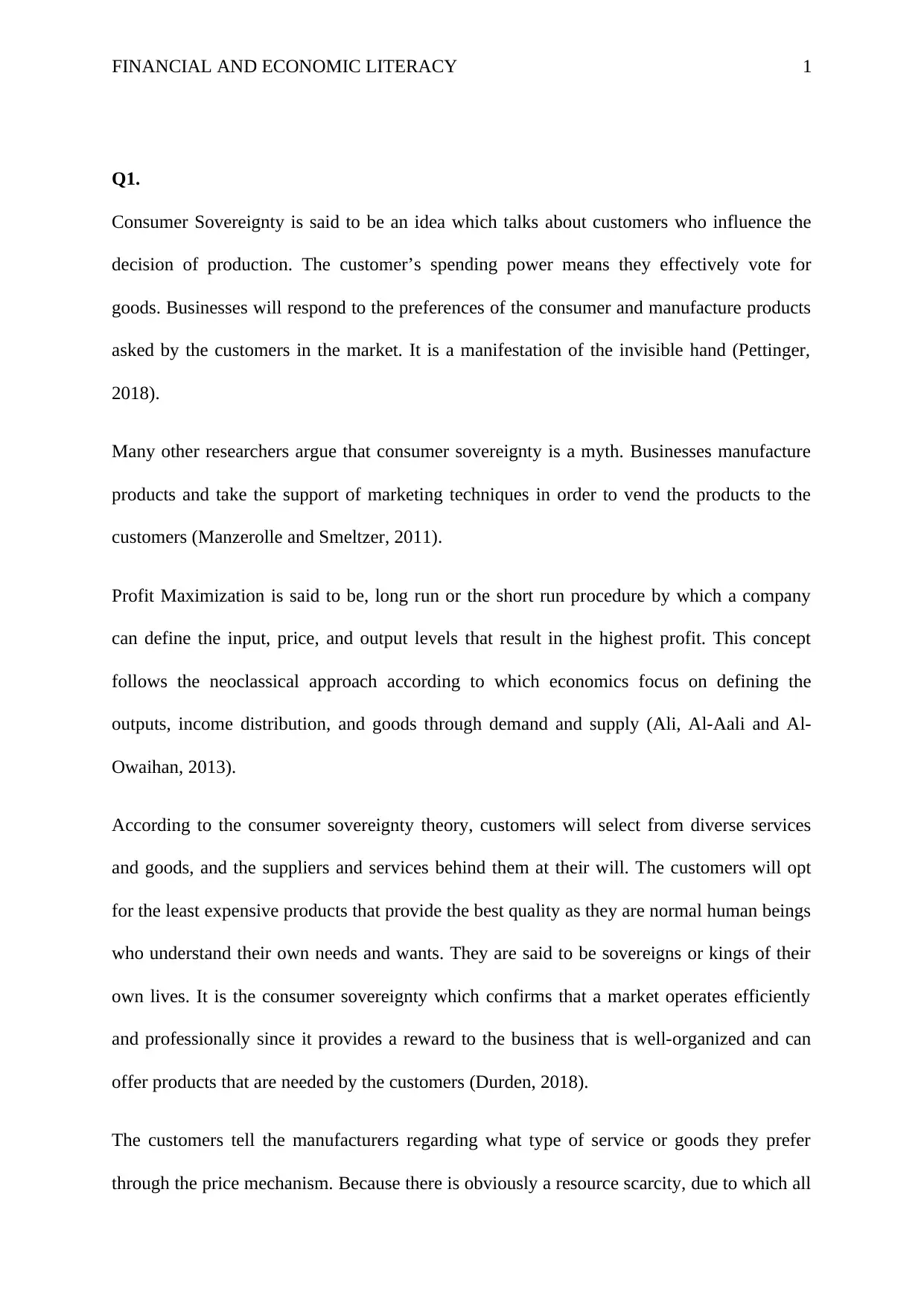
FINANCIAL AND ECONOMIC LITERACY 1
Q1.
Consumer Sovereignty is said to be an idea which talks about customers who influence the
decision of production. The customer’s spending power means they effectively vote for
goods. Businesses will respond to the preferences of the consumer and manufacture products
asked by the customers in the market. It is a manifestation of the invisible hand (Pettinger,
2018).
Many other researchers argue that consumer sovereignty is a myth. Businesses manufacture
products and take the support of marketing techniques in order to vend the products to the
customers (Manzerolle and Smeltzer, 2011).
Profit Maximization is said to be, long run or the short run procedure by which a company
can define the input, price, and output levels that result in the highest profit. This concept
follows the neoclassical approach according to which economics focus on defining the
outputs, income distribution, and goods through demand and supply (Ali, Al-Aali and Al-
Owaihan, 2013).
According to the consumer sovereignty theory, customers will select from diverse services
and goods, and the suppliers and services behind them at their will. The customers will opt
for the least expensive products that provide the best quality as they are normal human beings
who understand their own needs and wants. They are said to be sovereigns or kings of their
own lives. It is the consumer sovereignty which confirms that a market operates efficiently
and professionally since it provides a reward to the business that is well-organized and can
offer products that are needed by the customers (Durden, 2018).
The customers tell the manufacturers regarding what type of service or goods they prefer
through the price mechanism. Because there is obviously a resource scarcity, due to which all
Q1.
Consumer Sovereignty is said to be an idea which talks about customers who influence the
decision of production. The customer’s spending power means they effectively vote for
goods. Businesses will respond to the preferences of the consumer and manufacture products
asked by the customers in the market. It is a manifestation of the invisible hand (Pettinger,
2018).
Many other researchers argue that consumer sovereignty is a myth. Businesses manufacture
products and take the support of marketing techniques in order to vend the products to the
customers (Manzerolle and Smeltzer, 2011).
Profit Maximization is said to be, long run or the short run procedure by which a company
can define the input, price, and output levels that result in the highest profit. This concept
follows the neoclassical approach according to which economics focus on defining the
outputs, income distribution, and goods through demand and supply (Ali, Al-Aali and Al-
Owaihan, 2013).
According to the consumer sovereignty theory, customers will select from diverse services
and goods, and the suppliers and services behind them at their will. The customers will opt
for the least expensive products that provide the best quality as they are normal human beings
who understand their own needs and wants. They are said to be sovereigns or kings of their
own lives. It is the consumer sovereignty which confirms that a market operates efficiently
and professionally since it provides a reward to the business that is well-organized and can
offer products that are needed by the customers (Durden, 2018).
The customers tell the manufacturers regarding what type of service or goods they prefer
through the price mechanism. Because there is obviously a resource scarcity, due to which all
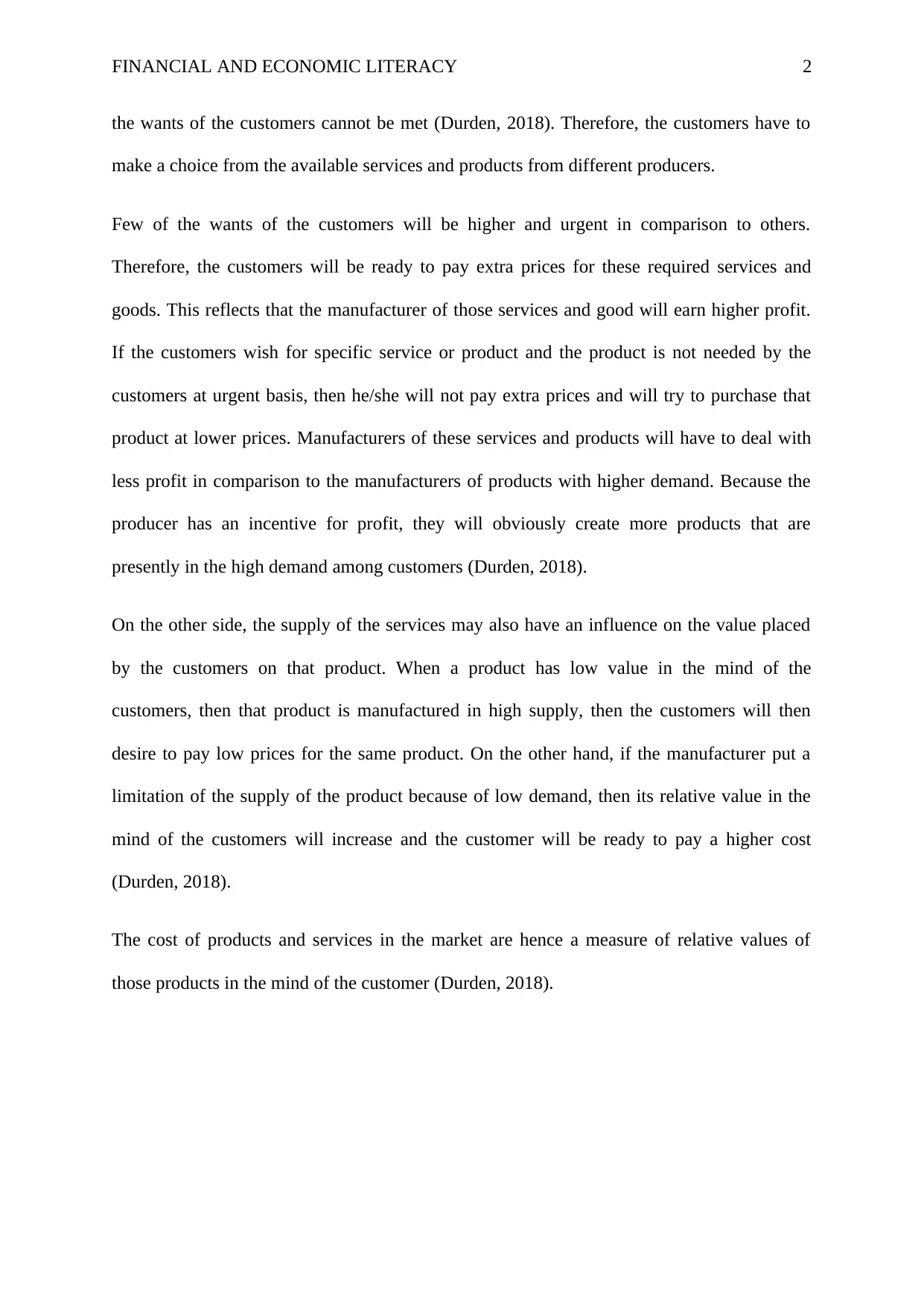
FINANCIAL AND ECONOMIC LITERACY 2
the wants of the customers cannot be met (Durden, 2018). Therefore, the customers have to
make a choice from the available services and products from different producers.
Few of the wants of the customers will be higher and urgent in comparison to others.
Therefore, the customers will be ready to pay extra prices for these required services and
goods. This reflects that the manufacturer of those services and good will earn higher profit.
If the customers wish for specific service or product and the product is not needed by the
customers at urgent basis, then he/she will not pay extra prices and will try to purchase that
product at lower prices. Manufacturers of these services and products will have to deal with
less profit in comparison to the manufacturers of products with higher demand. Because the
producer has an incentive for profit, they will obviously create more products that are
presently in the high demand among customers (Durden, 2018).
On the other side, the supply of the services may also have an influence on the value placed
by the customers on that product. When a product has low value in the mind of the
customers, then that product is manufactured in high supply, then the customers will then
desire to pay low prices for the same product. On the other hand, if the manufacturer put a
limitation of the supply of the product because of low demand, then its relative value in the
mind of the customers will increase and the customer will be ready to pay a higher cost
(Durden, 2018).
The cost of products and services in the market are hence a measure of relative values of
those products in the mind of the customer (Durden, 2018).
the wants of the customers cannot be met (Durden, 2018). Therefore, the customers have to
make a choice from the available services and products from different producers.
Few of the wants of the customers will be higher and urgent in comparison to others.
Therefore, the customers will be ready to pay extra prices for these required services and
goods. This reflects that the manufacturer of those services and good will earn higher profit.
If the customers wish for specific service or product and the product is not needed by the
customers at urgent basis, then he/she will not pay extra prices and will try to purchase that
product at lower prices. Manufacturers of these services and products will have to deal with
less profit in comparison to the manufacturers of products with higher demand. Because the
producer has an incentive for profit, they will obviously create more products that are
presently in the high demand among customers (Durden, 2018).
On the other side, the supply of the services may also have an influence on the value placed
by the customers on that product. When a product has low value in the mind of the
customers, then that product is manufactured in high supply, then the customers will then
desire to pay low prices for the same product. On the other hand, if the manufacturer put a
limitation of the supply of the product because of low demand, then its relative value in the
mind of the customers will increase and the customer will be ready to pay a higher cost
(Durden, 2018).
The cost of products and services in the market are hence a measure of relative values of
those products in the mind of the customer (Durden, 2018).
⊘ This is a preview!⊘
Do you want full access?
Subscribe today to unlock all pages.

Trusted by 1+ million students worldwide
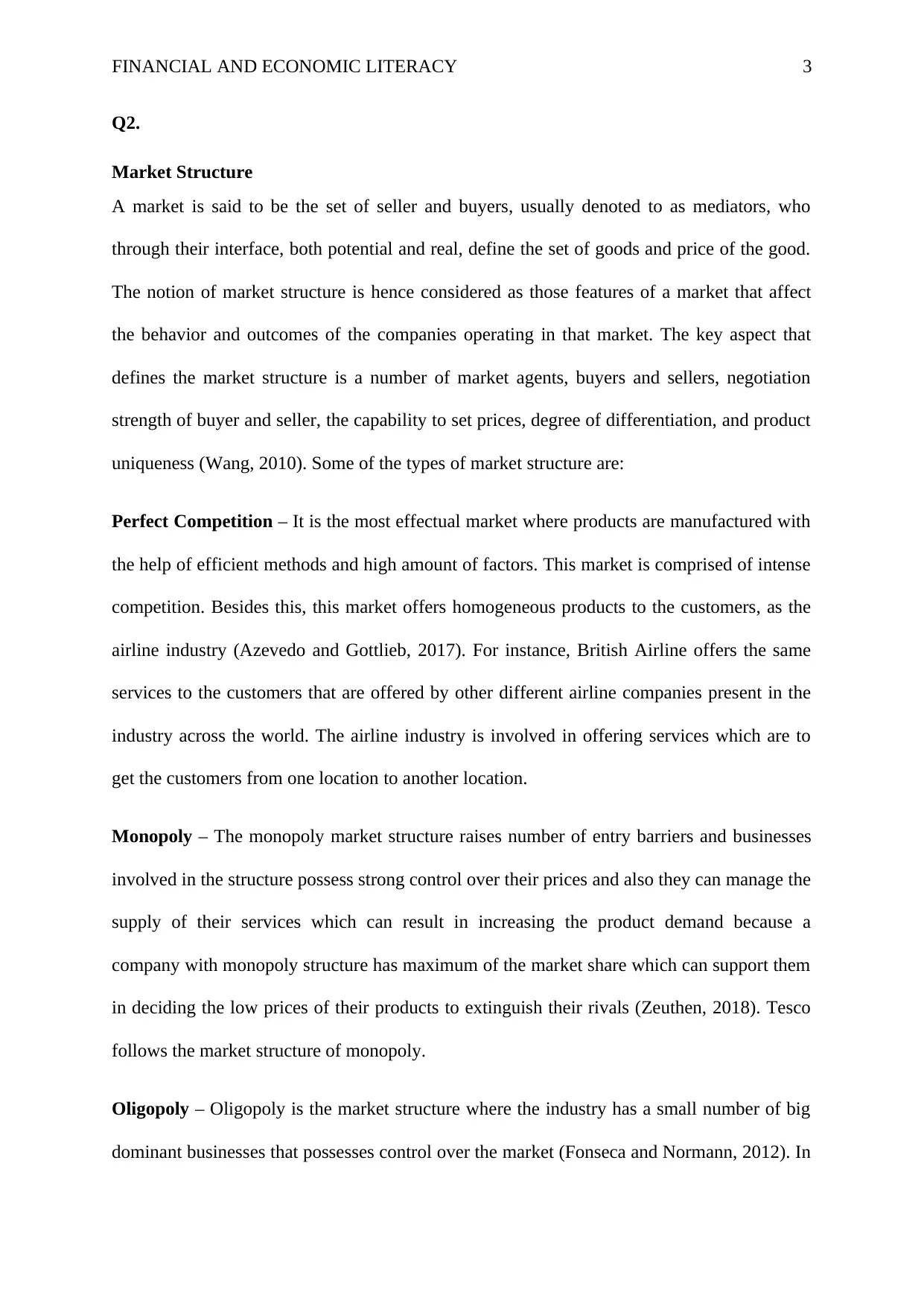
FINANCIAL AND ECONOMIC LITERACY 3
Q2.
Market Structure
A market is said to be the set of seller and buyers, usually denoted to as mediators, who
through their interface, both potential and real, define the set of goods and price of the good.
The notion of market structure is hence considered as those features of a market that affect
the behavior and outcomes of the companies operating in that market. The key aspect that
defines the market structure is a number of market agents, buyers and sellers, negotiation
strength of buyer and seller, the capability to set prices, degree of differentiation, and product
uniqueness (Wang, 2010). Some of the types of market structure are:
Perfect Competition – It is the most effectual market where products are manufactured with
the help of efficient methods and high amount of factors. This market is comprised of intense
competition. Besides this, this market offers homogeneous products to the customers, as the
airline industry (Azevedo and Gottlieb, 2017). For instance, British Airline offers the same
services to the customers that are offered by other different airline companies present in the
industry across the world. The airline industry is involved in offering services which are to
get the customers from one location to another location.
Monopoly – The monopoly market structure raises number of entry barriers and businesses
involved in the structure possess strong control over their prices and also they can manage the
supply of their services which can result in increasing the product demand because a
company with monopoly structure has maximum of the market share which can support them
in deciding the low prices of their products to extinguish their rivals (Zeuthen, 2018). Tesco
follows the market structure of monopoly.
Oligopoly – Oligopoly is the market structure where the industry has a small number of big
dominant businesses that possesses control over the market (Fonseca and Normann, 2012). In
Q2.
Market Structure
A market is said to be the set of seller and buyers, usually denoted to as mediators, who
through their interface, both potential and real, define the set of goods and price of the good.
The notion of market structure is hence considered as those features of a market that affect
the behavior and outcomes of the companies operating in that market. The key aspect that
defines the market structure is a number of market agents, buyers and sellers, negotiation
strength of buyer and seller, the capability to set prices, degree of differentiation, and product
uniqueness (Wang, 2010). Some of the types of market structure are:
Perfect Competition – It is the most effectual market where products are manufactured with
the help of efficient methods and high amount of factors. This market is comprised of intense
competition. Besides this, this market offers homogeneous products to the customers, as the
airline industry (Azevedo and Gottlieb, 2017). For instance, British Airline offers the same
services to the customers that are offered by other different airline companies present in the
industry across the world. The airline industry is involved in offering services which are to
get the customers from one location to another location.
Monopoly – The monopoly market structure raises number of entry barriers and businesses
involved in the structure possess strong control over their prices and also they can manage the
supply of their services which can result in increasing the product demand because a
company with monopoly structure has maximum of the market share which can support them
in deciding the low prices of their products to extinguish their rivals (Zeuthen, 2018). Tesco
follows the market structure of monopoly.
Oligopoly – Oligopoly is the market structure where the industry has a small number of big
dominant businesses that possesses control over the market (Fonseca and Normann, 2012). In
Paraphrase This Document
Need a fresh take? Get an instant paraphrase of this document with our AI Paraphraser
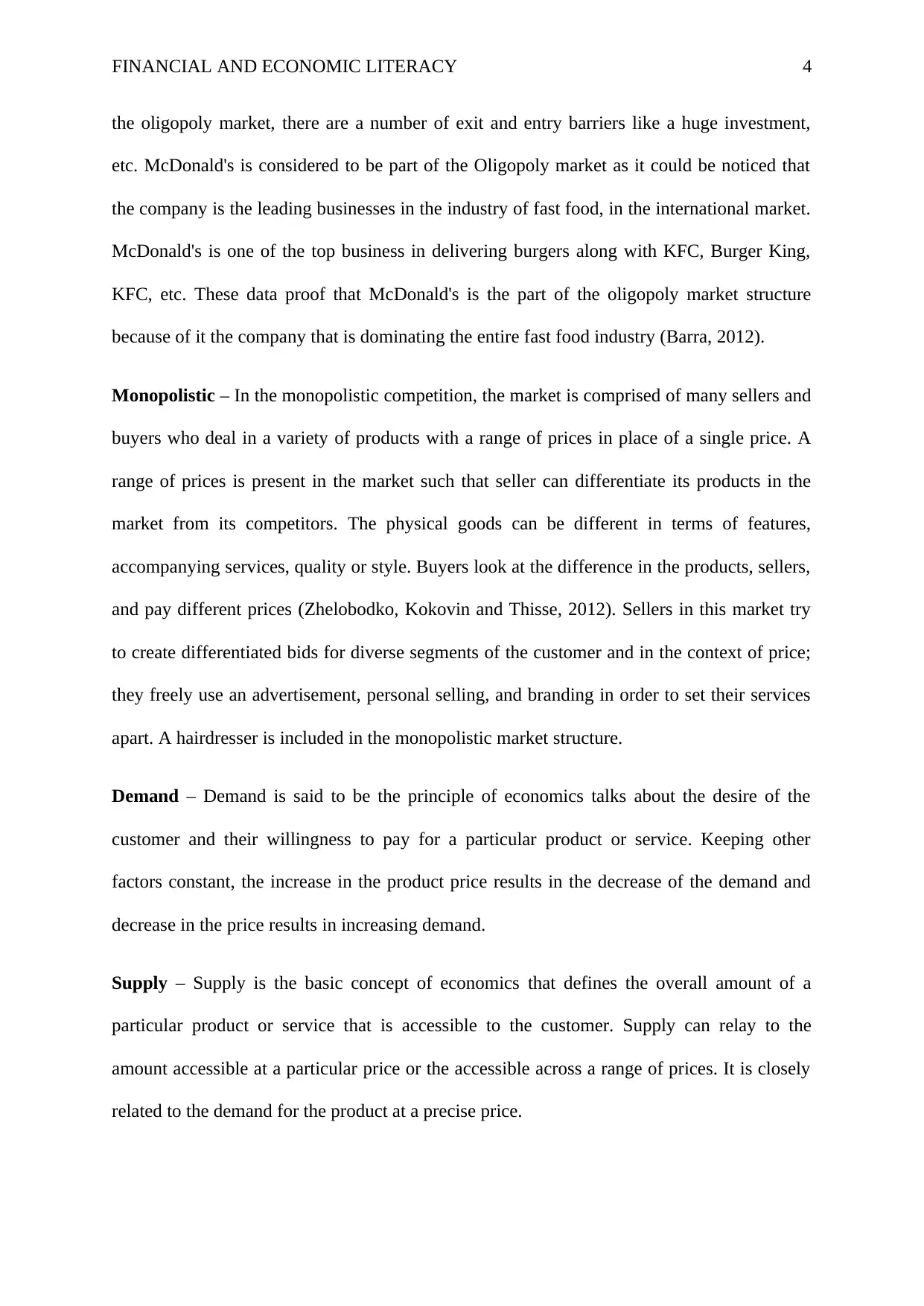
FINANCIAL AND ECONOMIC LITERACY 4
the oligopoly market, there are a number of exit and entry barriers like a huge investment,
etc. McDonald's is considered to be part of the Oligopoly market as it could be noticed that
the company is the leading businesses in the industry of fast food, in the international market.
McDonald's is one of the top business in delivering burgers along with KFC, Burger King,
KFC, etc. These data proof that McDonald's is the part of the oligopoly market structure
because of it the company that is dominating the entire fast food industry (Barra, 2012).
Monopolistic – In the monopolistic competition, the market is comprised of many sellers and
buyers who deal in a variety of products with a range of prices in place of a single price. A
range of prices is present in the market such that seller can differentiate its products in the
market from its competitors. The physical goods can be different in terms of features,
accompanying services, quality or style. Buyers look at the difference in the products, sellers,
and pay different prices (Zhelobodko, Kokovin and Thisse, 2012). Sellers in this market try
to create differentiated bids for diverse segments of the customer and in the context of price;
they freely use an advertisement, personal selling, and branding in order to set their services
apart. A hairdresser is included in the monopolistic market structure.
Demand – Demand is said to be the principle of economics talks about the desire of the
customer and their willingness to pay for a particular product or service. Keeping other
factors constant, the increase in the product price results in the decrease of the demand and
decrease in the price results in increasing demand.
Supply – Supply is the basic concept of economics that defines the overall amount of a
particular product or service that is accessible to the customer. Supply can relay to the
amount accessible at a particular price or the accessible across a range of prices. It is closely
related to the demand for the product at a precise price.
the oligopoly market, there are a number of exit and entry barriers like a huge investment,
etc. McDonald's is considered to be part of the Oligopoly market as it could be noticed that
the company is the leading businesses in the industry of fast food, in the international market.
McDonald's is one of the top business in delivering burgers along with KFC, Burger King,
KFC, etc. These data proof that McDonald's is the part of the oligopoly market structure
because of it the company that is dominating the entire fast food industry (Barra, 2012).
Monopolistic – In the monopolistic competition, the market is comprised of many sellers and
buyers who deal in a variety of products with a range of prices in place of a single price. A
range of prices is present in the market such that seller can differentiate its products in the
market from its competitors. The physical goods can be different in terms of features,
accompanying services, quality or style. Buyers look at the difference in the products, sellers,
and pay different prices (Zhelobodko, Kokovin and Thisse, 2012). Sellers in this market try
to create differentiated bids for diverse segments of the customer and in the context of price;
they freely use an advertisement, personal selling, and branding in order to set their services
apart. A hairdresser is included in the monopolistic market structure.
Demand – Demand is said to be the principle of economics talks about the desire of the
customer and their willingness to pay for a particular product or service. Keeping other
factors constant, the increase in the product price results in the decrease of the demand and
decrease in the price results in increasing demand.
Supply – Supply is the basic concept of economics that defines the overall amount of a
particular product or service that is accessible to the customer. Supply can relay to the
amount accessible at a particular price or the accessible across a range of prices. It is closely
related to the demand for the product at a precise price.
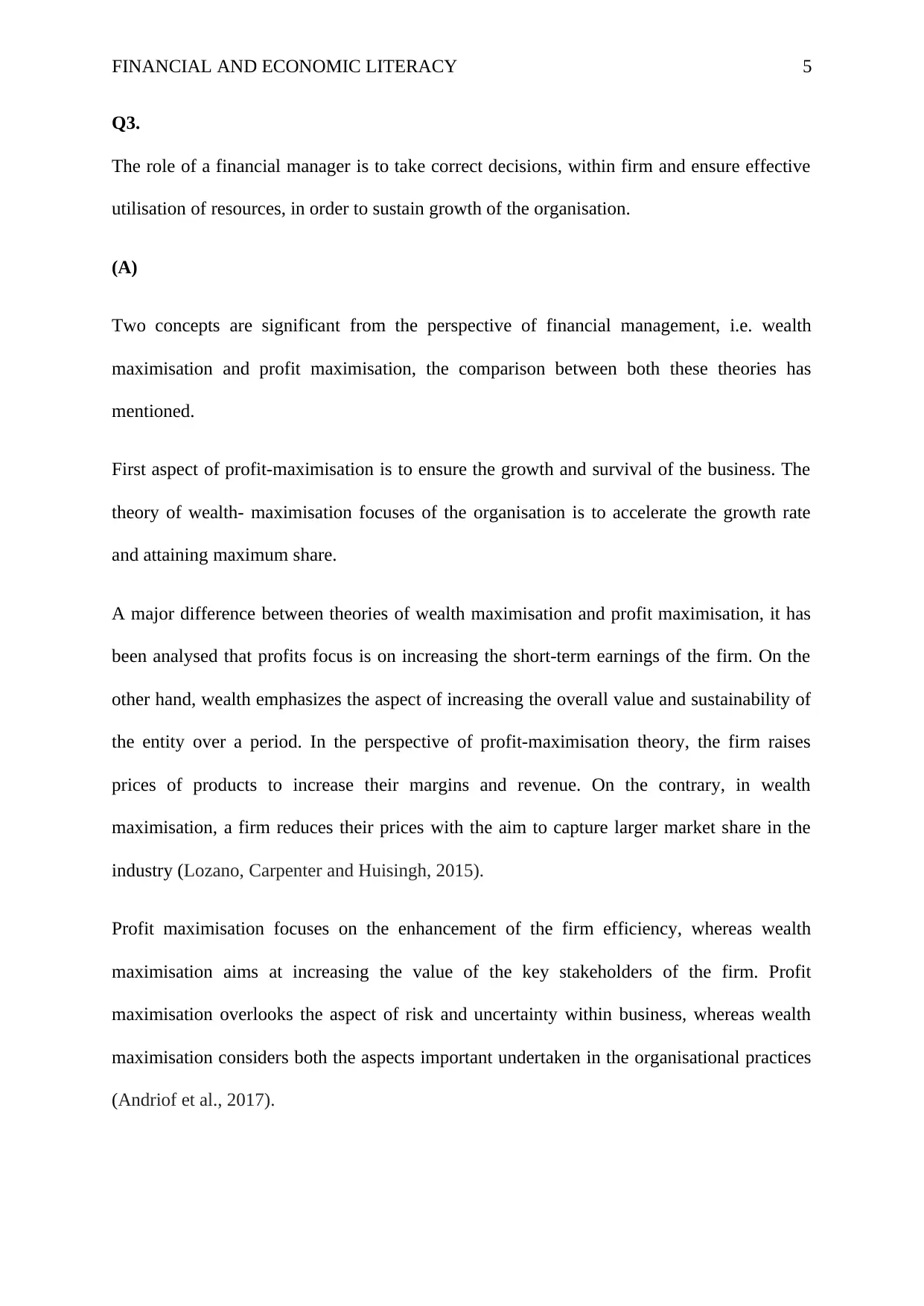
FINANCIAL AND ECONOMIC LITERACY 5
Q3.
The role of a financial manager is to take correct decisions, within firm and ensure effective
utilisation of resources, in order to sustain growth of the organisation.
(A)
Two concepts are significant from the perspective of financial management, i.e. wealth
maximisation and profit maximisation, the comparison between both these theories has
mentioned.
First aspect of profit-maximisation is to ensure the growth and survival of the business. The
theory of wealth- maximisation focuses of the organisation is to accelerate the growth rate
and attaining maximum share.
A major difference between theories of wealth maximisation and profit maximisation, it has
been analysed that profits focus is on increasing the short-term earnings of the firm. On the
other hand, wealth emphasizes the aspect of increasing the overall value and sustainability of
the entity over a period. In the perspective of profit-maximisation theory, the firm raises
prices of products to increase their margins and revenue. On the contrary, in wealth
maximisation, a firm reduces their prices with the aim to capture larger market share in the
industry (Lozano, Carpenter and Huisingh, 2015).
Profit maximisation focuses on the enhancement of the firm efficiency, whereas wealth
maximisation aims at increasing the value of the key stakeholders of the firm. Profit
maximisation overlooks the aspect of risk and uncertainty within business, whereas wealth
maximisation considers both the aspects important undertaken in the organisational practices
(Andriof et al., 2017).
Q3.
The role of a financial manager is to take correct decisions, within firm and ensure effective
utilisation of resources, in order to sustain growth of the organisation.
(A)
Two concepts are significant from the perspective of financial management, i.e. wealth
maximisation and profit maximisation, the comparison between both these theories has
mentioned.
First aspect of profit-maximisation is to ensure the growth and survival of the business. The
theory of wealth- maximisation focuses of the organisation is to accelerate the growth rate
and attaining maximum share.
A major difference between theories of wealth maximisation and profit maximisation, it has
been analysed that profits focus is on increasing the short-term earnings of the firm. On the
other hand, wealth emphasizes the aspect of increasing the overall value and sustainability of
the entity over a period. In the perspective of profit-maximisation theory, the firm raises
prices of products to increase their margins and revenue. On the contrary, in wealth
maximisation, a firm reduces their prices with the aim to capture larger market share in the
industry (Lozano, Carpenter and Huisingh, 2015).
Profit maximisation focuses on the enhancement of the firm efficiency, whereas wealth
maximisation aims at increasing the value of the key stakeholders of the firm. Profit
maximisation overlooks the aspect of risk and uncertainty within business, whereas wealth
maximisation considers both the aspects important undertaken in the organisational practices
(Andriof et al., 2017).
⊘ This is a preview!⊘
Do you want full access?
Subscribe today to unlock all pages.

Trusted by 1+ million students worldwide
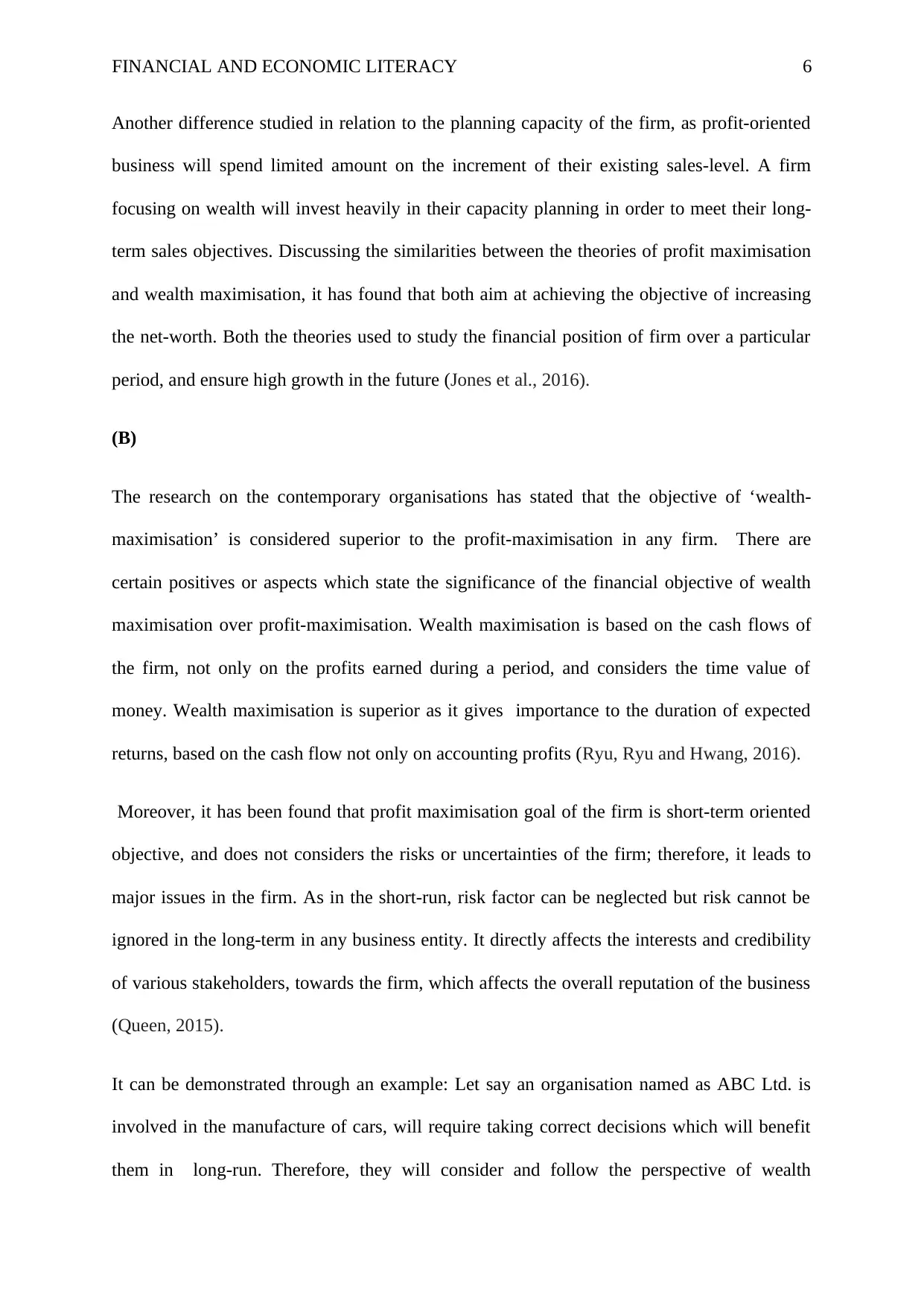
FINANCIAL AND ECONOMIC LITERACY 6
Another difference studied in relation to the planning capacity of the firm, as profit-oriented
business will spend limited amount on the increment of their existing sales-level. A firm
focusing on wealth will invest heavily in their capacity planning in order to meet their long-
term sales objectives. Discussing the similarities between the theories of profit maximisation
and wealth maximisation, it has found that both aim at achieving the objective of increasing
the net-worth. Both the theories used to study the financial position of firm over a particular
period, and ensure high growth in the future (Jones et al., 2016).
(B)
The research on the contemporary organisations has stated that the objective of ‘wealth-
maximisation’ is considered superior to the profit-maximisation in any firm. There are
certain positives or aspects which state the significance of the financial objective of wealth
maximisation over profit-maximisation. Wealth maximisation is based on the cash flows of
the firm, not only on the profits earned during a period, and considers the time value of
money. Wealth maximisation is superior as it gives importance to the duration of expected
returns, based on the cash flow not only on accounting profits (Ryu, Ryu and Hwang, 2016).
Moreover, it has been found that profit maximisation goal of the firm is short-term oriented
objective, and does not considers the risks or uncertainties of the firm; therefore, it leads to
major issues in the firm. As in the short-run, risk factor can be neglected but risk cannot be
ignored in the long-term in any business entity. It directly affects the interests and credibility
of various stakeholders, towards the firm, which affects the overall reputation of the business
(Queen, 2015).
It can be demonstrated through an example: Let say an organisation named as ABC Ltd. is
involved in the manufacture of cars, will require taking correct decisions which will benefit
them in long-run. Therefore, they will consider and follow the perspective of wealth
Another difference studied in relation to the planning capacity of the firm, as profit-oriented
business will spend limited amount on the increment of their existing sales-level. A firm
focusing on wealth will invest heavily in their capacity planning in order to meet their long-
term sales objectives. Discussing the similarities between the theories of profit maximisation
and wealth maximisation, it has found that both aim at achieving the objective of increasing
the net-worth. Both the theories used to study the financial position of firm over a particular
period, and ensure high growth in the future (Jones et al., 2016).
(B)
The research on the contemporary organisations has stated that the objective of ‘wealth-
maximisation’ is considered superior to the profit-maximisation in any firm. There are
certain positives or aspects which state the significance of the financial objective of wealth
maximisation over profit-maximisation. Wealth maximisation is based on the cash flows of
the firm, not only on the profits earned during a period, and considers the time value of
money. Wealth maximisation is superior as it gives importance to the duration of expected
returns, based on the cash flow not only on accounting profits (Ryu, Ryu and Hwang, 2016).
Moreover, it has been found that profit maximisation goal of the firm is short-term oriented
objective, and does not considers the risks or uncertainties of the firm; therefore, it leads to
major issues in the firm. As in the short-run, risk factor can be neglected but risk cannot be
ignored in the long-term in any business entity. It directly affects the interests and credibility
of various stakeholders, towards the firm, which affects the overall reputation of the business
(Queen, 2015).
It can be demonstrated through an example: Let say an organisation named as ABC Ltd. is
involved in the manufacture of cars, will require taking correct decisions which will benefit
them in long-run. Therefore, they will consider and follow the perspective of wealth
Paraphrase This Document
Need a fresh take? Get an instant paraphrase of this document with our AI Paraphraser
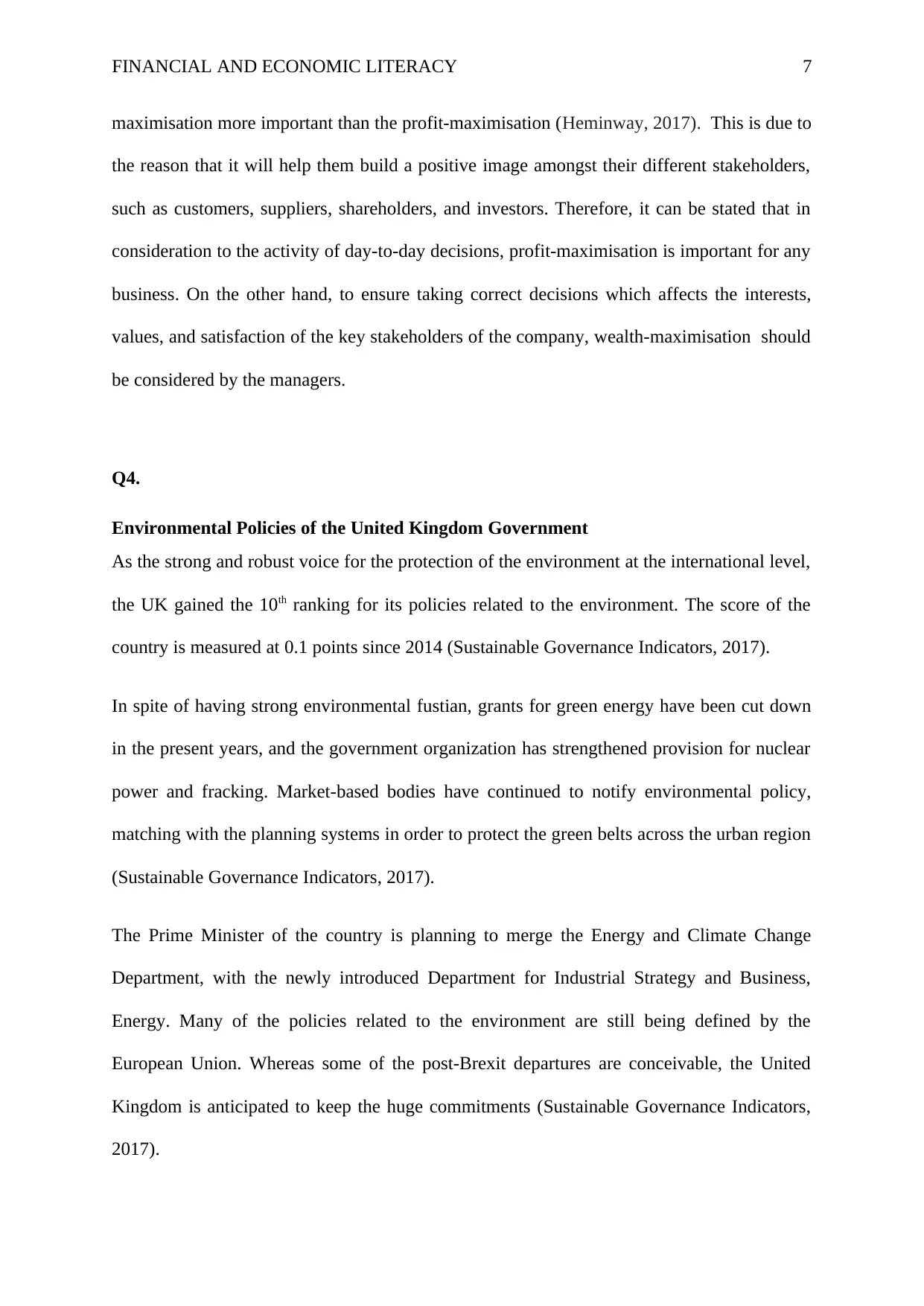
FINANCIAL AND ECONOMIC LITERACY 7
maximisation more important than the profit-maximisation (Heminway, 2017). This is due to
the reason that it will help them build a positive image amongst their different stakeholders,
such as customers, suppliers, shareholders, and investors. Therefore, it can be stated that in
consideration to the activity of day-to-day decisions, profit-maximisation is important for any
business. On the other hand, to ensure taking correct decisions which affects the interests,
values, and satisfaction of the key stakeholders of the company, wealth-maximisation should
be considered by the managers.
Q4.
Environmental Policies of the United Kingdom Government
As the strong and robust voice for the protection of the environment at the international level,
the UK gained the 10th ranking for its policies related to the environment. The score of the
country is measured at 0.1 points since 2014 (Sustainable Governance Indicators, 2017).
In spite of having strong environmental fustian, grants for green energy have been cut down
in the present years, and the government organization has strengthened provision for nuclear
power and fracking. Market-based bodies have continued to notify environmental policy,
matching with the planning systems in order to protect the green belts across the urban region
(Sustainable Governance Indicators, 2017).
The Prime Minister of the country is planning to merge the Energy and Climate Change
Department, with the newly introduced Department for Industrial Strategy and Business,
Energy. Many of the policies related to the environment are still being defined by the
European Union. Whereas some of the post-Brexit departures are conceivable, the United
Kingdom is anticipated to keep the huge commitments (Sustainable Governance Indicators,
2017).
maximisation more important than the profit-maximisation (Heminway, 2017). This is due to
the reason that it will help them build a positive image amongst their different stakeholders,
such as customers, suppliers, shareholders, and investors. Therefore, it can be stated that in
consideration to the activity of day-to-day decisions, profit-maximisation is important for any
business. On the other hand, to ensure taking correct decisions which affects the interests,
values, and satisfaction of the key stakeholders of the company, wealth-maximisation should
be considered by the managers.
Q4.
Environmental Policies of the United Kingdom Government
As the strong and robust voice for the protection of the environment at the international level,
the UK gained the 10th ranking for its policies related to the environment. The score of the
country is measured at 0.1 points since 2014 (Sustainable Governance Indicators, 2017).
In spite of having strong environmental fustian, grants for green energy have been cut down
in the present years, and the government organization has strengthened provision for nuclear
power and fracking. Market-based bodies have continued to notify environmental policy,
matching with the planning systems in order to protect the green belts across the urban region
(Sustainable Governance Indicators, 2017).
The Prime Minister of the country is planning to merge the Energy and Climate Change
Department, with the newly introduced Department for Industrial Strategy and Business,
Energy. Many of the policies related to the environment are still being defined by the
European Union. Whereas some of the post-Brexit departures are conceivable, the United
Kingdom is anticipated to keep the huge commitments (Sustainable Governance Indicators,
2017).
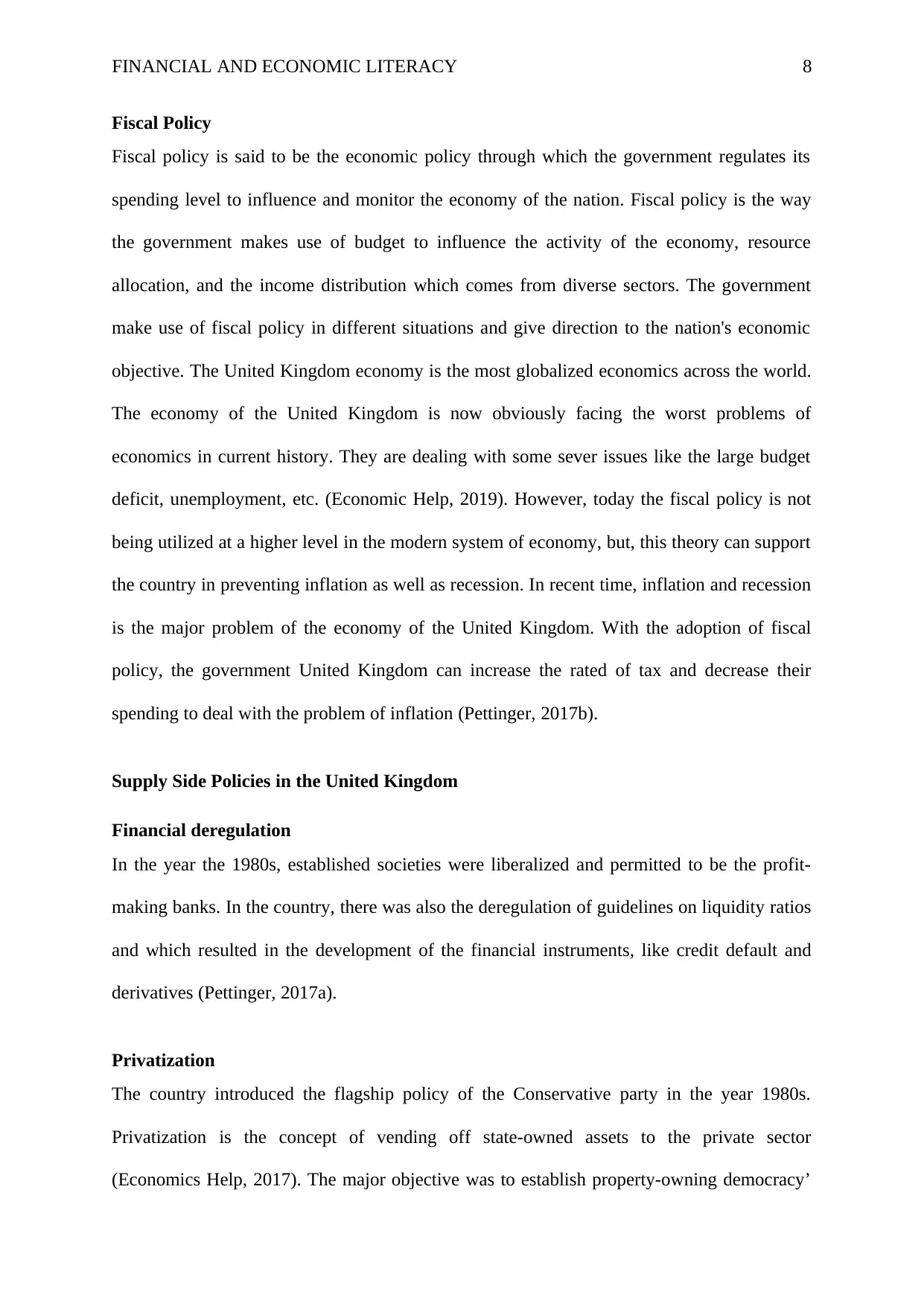
FINANCIAL AND ECONOMIC LITERACY 8
Fiscal Policy
Fiscal policy is said to be the economic policy through which the government regulates its
spending level to influence and monitor the economy of the nation. Fiscal policy is the way
the government makes use of budget to influence the activity of the economy, resource
allocation, and the income distribution which comes from diverse sectors. The government
make use of fiscal policy in different situations and give direction to the nation's economic
objective. The United Kingdom economy is the most globalized economics across the world.
The economy of the United Kingdom is now obviously facing the worst problems of
economics in current history. They are dealing with some sever issues like the large budget
deficit, unemployment, etc. (Economic Help, 2019). However, today the fiscal policy is not
being utilized at a higher level in the modern system of economy, but, this theory can support
the country in preventing inflation as well as recession. In recent time, inflation and recession
is the major problem of the economy of the United Kingdom. With the adoption of fiscal
policy, the government United Kingdom can increase the rated of tax and decrease their
spending to deal with the problem of inflation (Pettinger, 2017b).
Supply Side Policies in the United Kingdom
Financial deregulation
In the year the 1980s, established societies were liberalized and permitted to be the profit-
making banks. In the country, there was also the deregulation of guidelines on liquidity ratios
and which resulted in the development of the financial instruments, like credit default and
derivatives (Pettinger, 2017a).
Privatization
The country introduced the flagship policy of the Conservative party in the year 1980s.
Privatization is the concept of vending off state-owned assets to the private sector
(Economics Help, 2017). The major objective was to establish property-owning democracy’
Fiscal Policy
Fiscal policy is said to be the economic policy through which the government regulates its
spending level to influence and monitor the economy of the nation. Fiscal policy is the way
the government makes use of budget to influence the activity of the economy, resource
allocation, and the income distribution which comes from diverse sectors. The government
make use of fiscal policy in different situations and give direction to the nation's economic
objective. The United Kingdom economy is the most globalized economics across the world.
The economy of the United Kingdom is now obviously facing the worst problems of
economics in current history. They are dealing with some sever issues like the large budget
deficit, unemployment, etc. (Economic Help, 2019). However, today the fiscal policy is not
being utilized at a higher level in the modern system of economy, but, this theory can support
the country in preventing inflation as well as recession. In recent time, inflation and recession
is the major problem of the economy of the United Kingdom. With the adoption of fiscal
policy, the government United Kingdom can increase the rated of tax and decrease their
spending to deal with the problem of inflation (Pettinger, 2017b).
Supply Side Policies in the United Kingdom
Financial deregulation
In the year the 1980s, established societies were liberalized and permitted to be the profit-
making banks. In the country, there was also the deregulation of guidelines on liquidity ratios
and which resulted in the development of the financial instruments, like credit default and
derivatives (Pettinger, 2017a).
Privatization
The country introduced the flagship policy of the Conservative party in the year 1980s.
Privatization is the concept of vending off state-owned assets to the private sector
(Economics Help, 2017). The major objective was to establish property-owning democracy’
⊘ This is a preview!⊘
Do you want full access?
Subscribe today to unlock all pages.

Trusted by 1+ million students worldwide
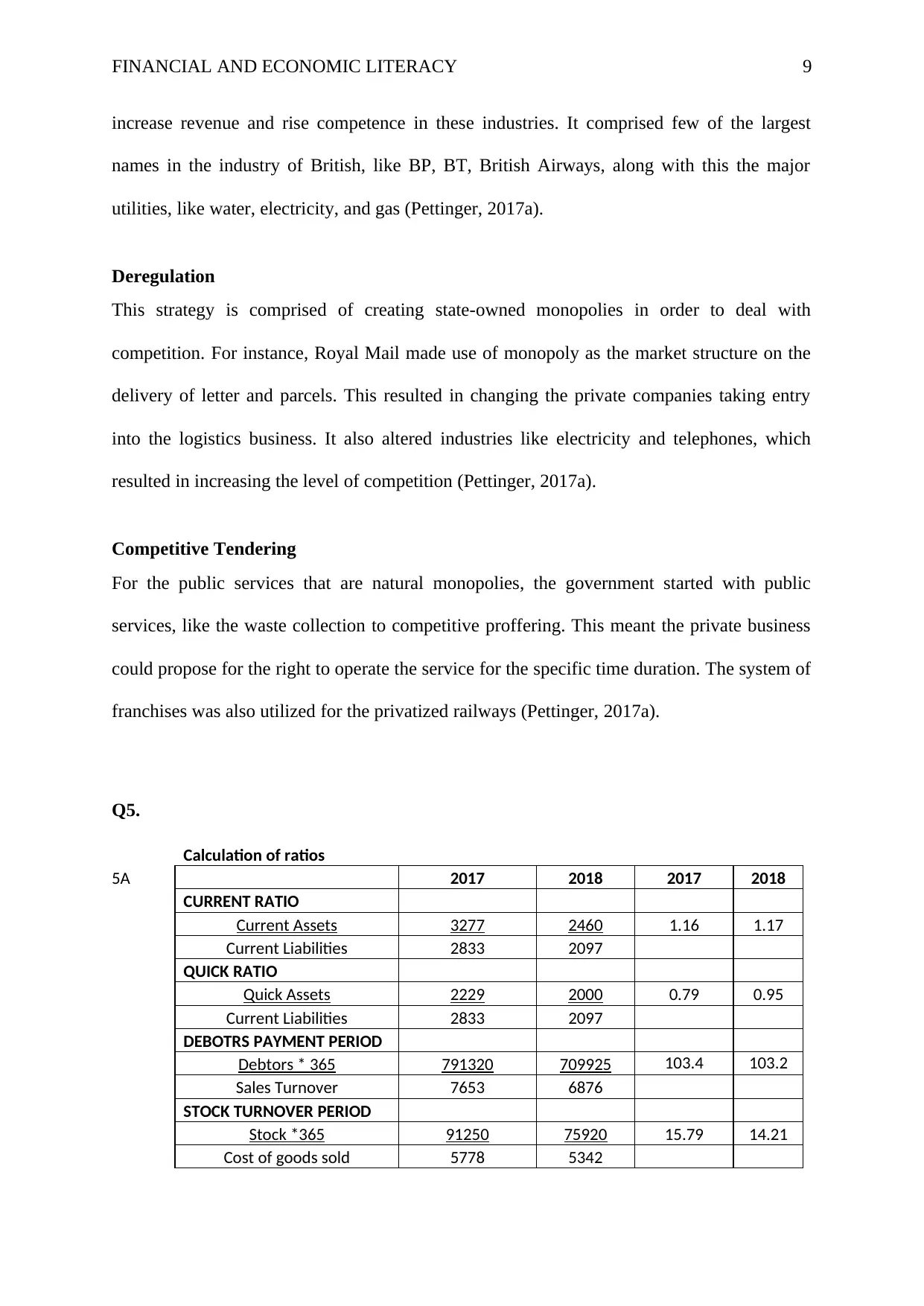
FINANCIAL AND ECONOMIC LITERACY 9
increase revenue and rise competence in these industries. It comprised few of the largest
names in the industry of British, like BP, BT, British Airways, along with this the major
utilities, like water, electricity, and gas (Pettinger, 2017a).
Deregulation
This strategy is comprised of creating state-owned monopolies in order to deal with
competition. For instance, Royal Mail made use of monopoly as the market structure on the
delivery of letter and parcels. This resulted in changing the private companies taking entry
into the logistics business. It also altered industries like electricity and telephones, which
resulted in increasing the level of competition (Pettinger, 2017a).
Competitive Tendering
For the public services that are natural monopolies, the government started with public
services, like the waste collection to competitive proffering. This meant the private business
could propose for the right to operate the service for the specific time duration. The system of
franchises was also utilized for the privatized railways (Pettinger, 2017a).
Q5.
Calculation of ratios
5A 2017 2018 2017 2018
CURRENT RATIO
Current Assets 3277 2460 1.16 1.17
Current Liabilities 2833 2097
QUICK RATIO
Quick Assets 2229 2000 0.79 0.95
Current Liabilities 2833 2097
DEBOTRS PAYMENT PERIOD
Debtors * 365 791320 709925 103.4 103.2
Sales Turnover 7653 6876
STOCK TURNOVER PERIOD
Stock *365 91250 75920 15.79 14.21
Cost of goods sold 5778 5342
increase revenue and rise competence in these industries. It comprised few of the largest
names in the industry of British, like BP, BT, British Airways, along with this the major
utilities, like water, electricity, and gas (Pettinger, 2017a).
Deregulation
This strategy is comprised of creating state-owned monopolies in order to deal with
competition. For instance, Royal Mail made use of monopoly as the market structure on the
delivery of letter and parcels. This resulted in changing the private companies taking entry
into the logistics business. It also altered industries like electricity and telephones, which
resulted in increasing the level of competition (Pettinger, 2017a).
Competitive Tendering
For the public services that are natural monopolies, the government started with public
services, like the waste collection to competitive proffering. This meant the private business
could propose for the right to operate the service for the specific time duration. The system of
franchises was also utilized for the privatized railways (Pettinger, 2017a).
Q5.
Calculation of ratios
5A 2017 2018 2017 2018
CURRENT RATIO
Current Assets 3277 2460 1.16 1.17
Current Liabilities 2833 2097
QUICK RATIO
Quick Assets 2229 2000 0.79 0.95
Current Liabilities 2833 2097
DEBOTRS PAYMENT PERIOD
Debtors * 365 791320 709925 103.4 103.2
Sales Turnover 7653 6876
STOCK TURNOVER PERIOD
Stock *365 91250 75920 15.79 14.21
Cost of goods sold 5778 5342
Paraphrase This Document
Need a fresh take? Get an instant paraphrase of this document with our AI Paraphraser
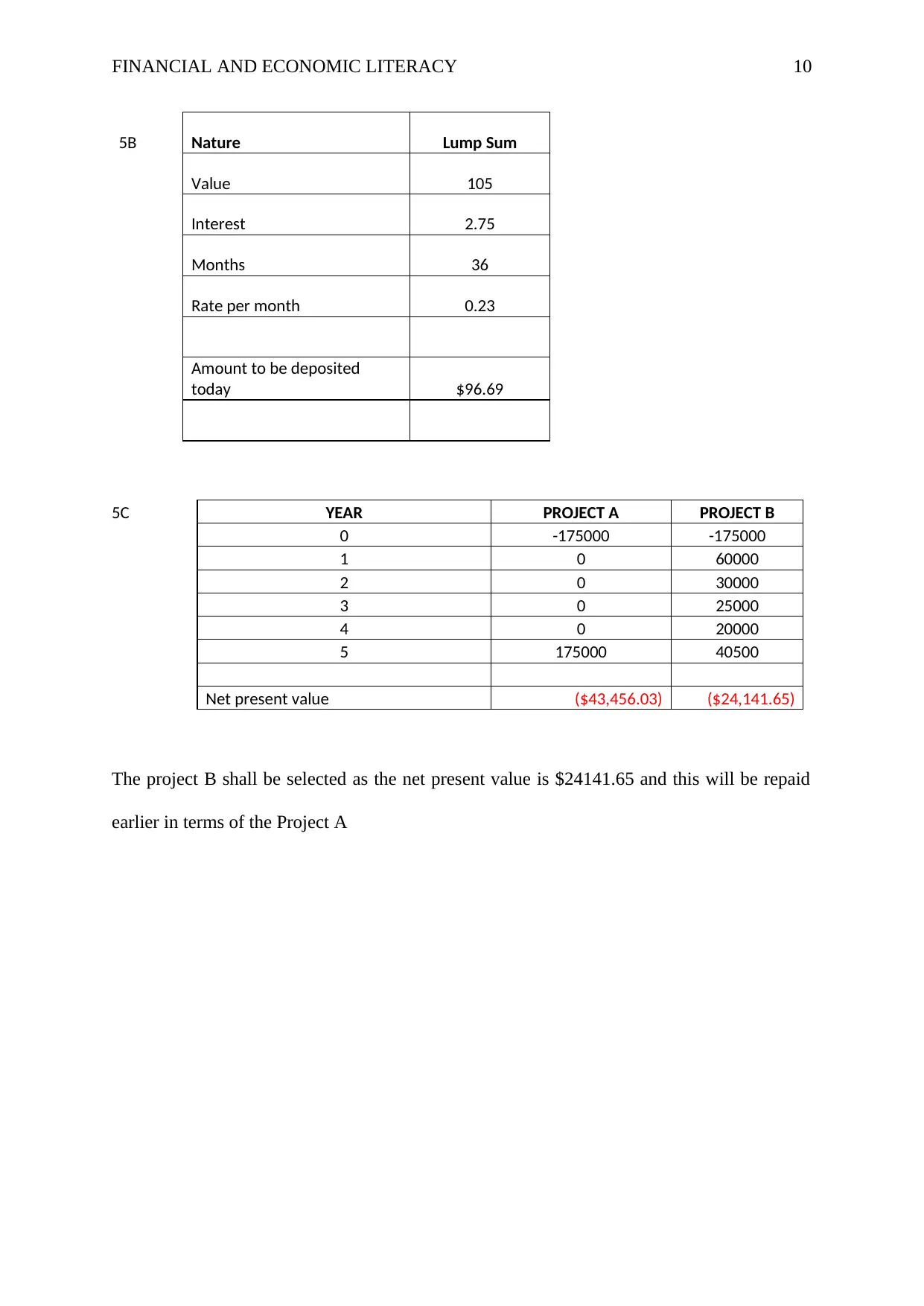
FINANCIAL AND ECONOMIC LITERACY 10
5B Nature Lump Sum
Value 105
Interest 2.75
Months 36
Rate per month 0.23
Amount to be deposited
today $96.69
5C YEAR PROJECT A PROJECT B
0 -175000 -175000
1 0 60000
2 0 30000
3 0 25000
4 0 20000
5 175000 40500
Net present value ($43,456.03) ($24,141.65)
The project B shall be selected as the net present value is $24141.65 and this will be repaid
earlier in terms of the Project A
5B Nature Lump Sum
Value 105
Interest 2.75
Months 36
Rate per month 0.23
Amount to be deposited
today $96.69
5C YEAR PROJECT A PROJECT B
0 -175000 -175000
1 0 60000
2 0 30000
3 0 25000
4 0 20000
5 175000 40500
Net present value ($43,456.03) ($24,141.65)
The project B shall be selected as the net present value is $24141.65 and this will be repaid
earlier in terms of the Project A
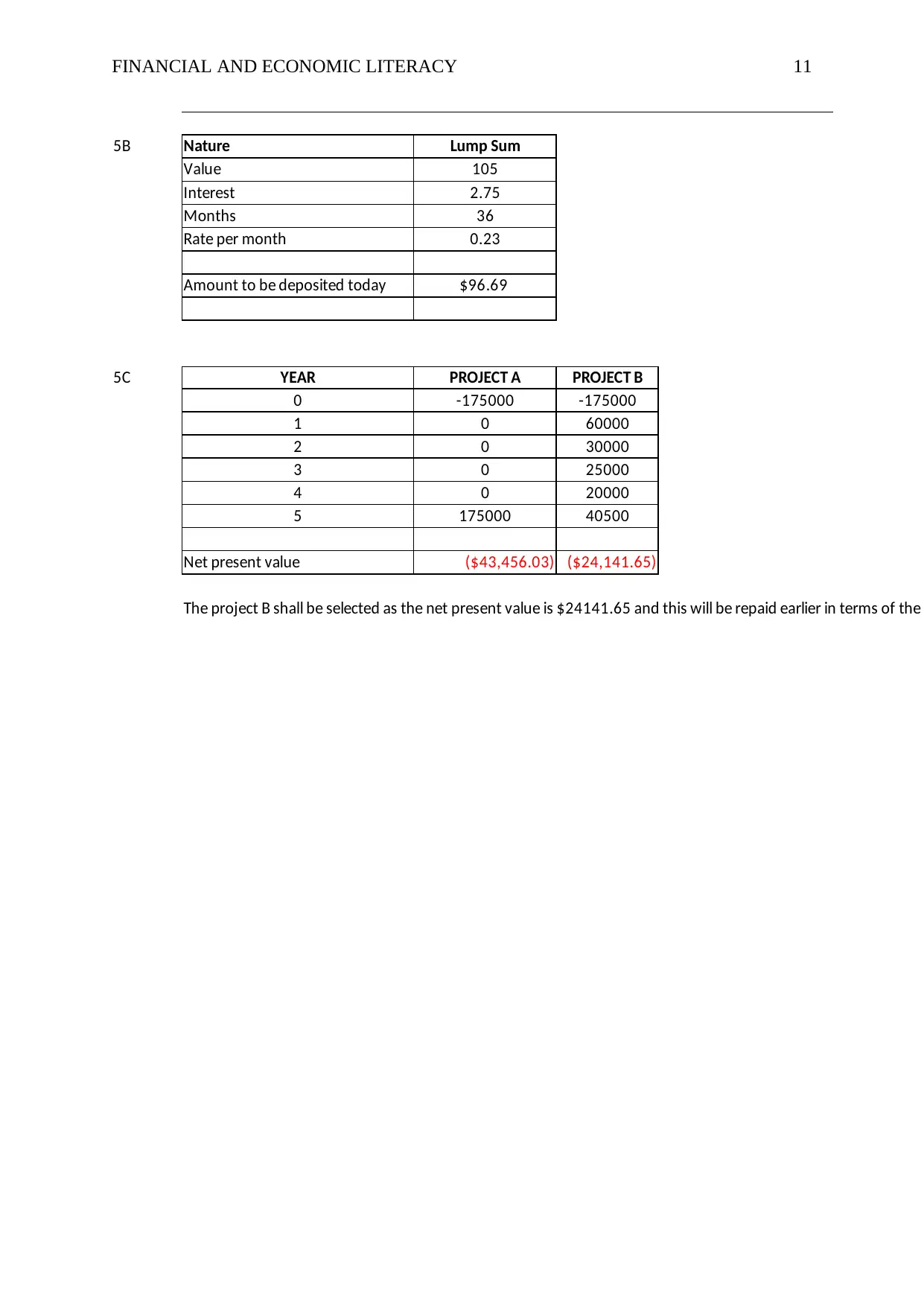
FINANCIAL AND ECONOMIC LITERACY 11
5B Nature Lump Sum
Value 105
Interest 2.75
Months 36
Rate per month 0.23
Amount to be deposited today $96.69
5C YEAR PROJECT A PROJECT B
0 -175000 -175000
1 0 60000
2 0 30000
3 0 25000
4 0 20000
5 175000 40500
Net present value ($43,456.03) ($24,141.65)
The project B shall be selected as the net present value is $24141.65 and this will be repaid earlier in terms of the
5B Nature Lump Sum
Value 105
Interest 2.75
Months 36
Rate per month 0.23
Amount to be deposited today $96.69
5C YEAR PROJECT A PROJECT B
0 -175000 -175000
1 0 60000
2 0 30000
3 0 25000
4 0 20000
5 175000 40500
Net present value ($43,456.03) ($24,141.65)
The project B shall be selected as the net present value is $24141.65 and this will be repaid earlier in terms of the
⊘ This is a preview!⊘
Do you want full access?
Subscribe today to unlock all pages.

Trusted by 1+ million students worldwide
1 out of 15
Related Documents
Your All-in-One AI-Powered Toolkit for Academic Success.
+13062052269
info@desklib.com
Available 24*7 on WhatsApp / Email
![[object Object]](/_next/static/media/star-bottom.7253800d.svg)
Unlock your academic potential
Copyright © 2020–2025 A2Z Services. All Rights Reserved. Developed and managed by ZUCOL.





